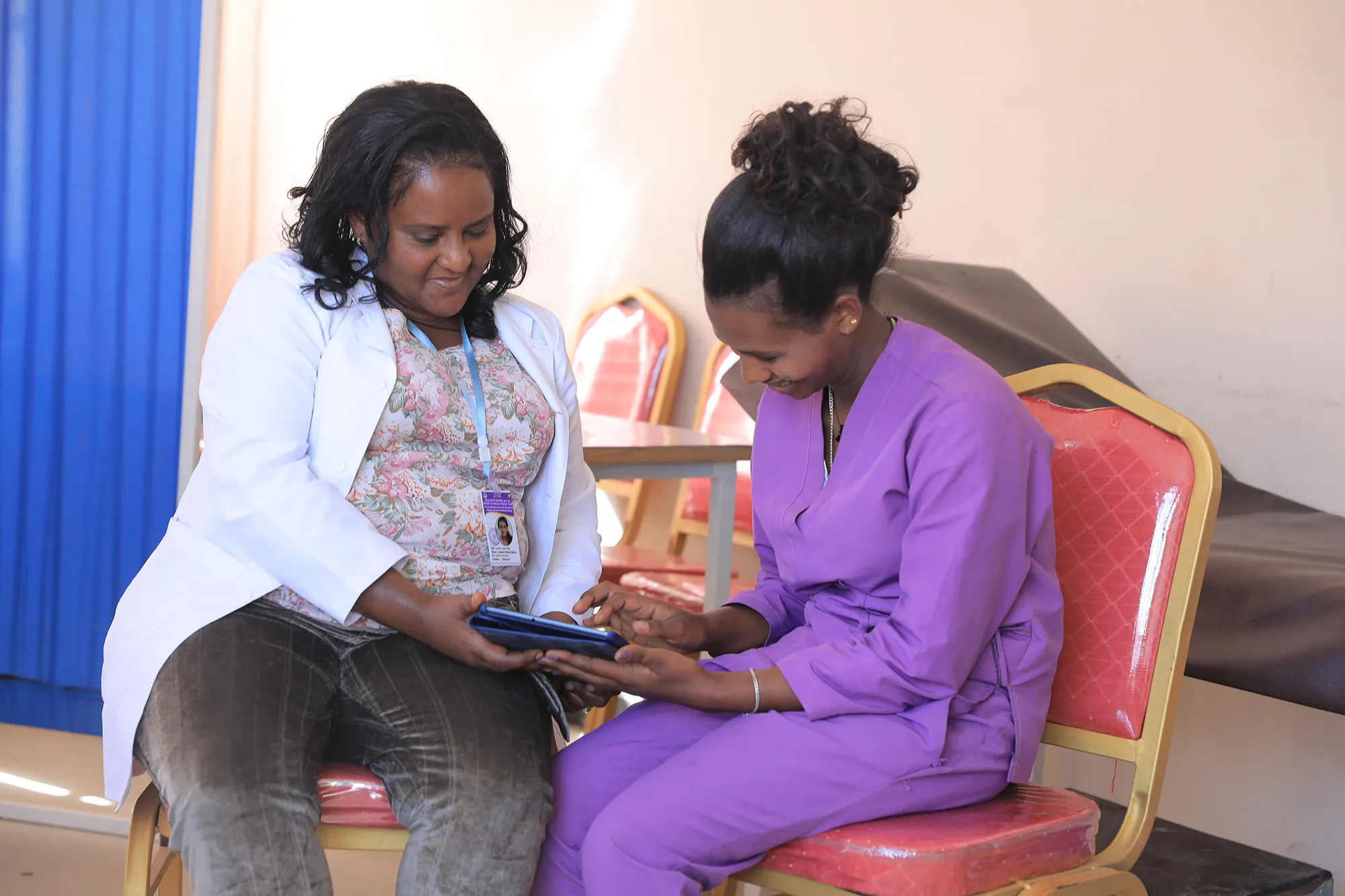From platforms providing much-needed medical information and support to diagnostic tools, ‘female technology’ devices – mostly designed by women for women – are filling a major gap in healthcare.
On New Year’s Eve 2023, instead of celebrating with friends and family, María Zurutuza was experiencing a miscarriage. But she and her husband did not have to navigate their personal tragedy alone.
Zurutuza was in frequent touch with her obstetrician through the mobile messaging service run by women’s health platform Plenna, giving her access to medical and moral support until she could meet her doctor at a clinic in Mexico City and, later, the local hospital. “The warmth and empathy of my doctors combined with the easy access I had to reliable information – it was so reassuring,” said Zurutuza.
When Zurutuza became pregnant once more almost a year later, she was anxious that she would miscarry again. But the advice and sense of community she got through the app helped put her at ease, she said. From the pregnancy tracker to blogs explaining common pregnancy symptoms and possible warning signs, the Spanish-language platform’s digital services helped her get through the first few nerve-wracking months of her pregnancy.
“The more information I have, the better my peace of mind,” said Zurutuza, whose daughter is now 4 months old. “Making appointments through the app, getting answers to my questions at 03:00 am from other mothers, being able to keep track of the whole pregnancy – yes, it’s all based around technology, but it’s not cold. It’s human and personal.”
Offering a hybrid of online and in-person support for women in Mexico, Plenna, which launched in 2020, is an example of the femtech innovations that are rapidly transforming women’s healthcare worldwide, addressing gaps that traditional systems have long overlooked.
Technologies such as telemedicine platforms, mobile health apps, wearable technology and diagnostic tools powered by artificial intelligence (AI) have the potential to help improve healthcare standards, reduce costs and give women the tools for self-care and early intervention.
But efforts to deploy and scale up these solutions still face numerous obstacles, including limited access to digital tech, cultural factors and socioeconomic inequalities.
Full access to all of the Plenna’s digital services plus its four physical clinics requires a membership. But co-founders Lorena Ostos Rangel and Giovanna Abramo also wanted any woman to be able to come to the platform for crucial health information. So, they made much of Plenna’s resources free to use, including nutrition advice, tips on breastfeeding and a questionnaire to help new mothers check if they might be experiencing postpartum depression.
“We want to help as many women as we can. Using technology, we can not only lower costs but also give patients the data and information they need to make the best choices about their bodies,” Ostos Rangel said.
Tech puts women’s health in their hands
Over the past decade, femtech – short for female technology – has evolved from simple menstrual cycle trackers to integrated platforms and apps, wearable gadgets that track comprehensive health data, and clinical and diagnostics tools – for example, a portable AI-powered device to detect potential breast cancer, designed for populations living in remote areas, or a device that helps prevents perineal tears during vaginal births.
Those are just two of the start-up projects currently supported by Tech4Eva, one of the world’s largest femtech accelerators. Since its first call for applications in 2021, Tech4Eva, managed by the nonprofit EPFL Innovation Park in Switzerland, has accelerated 110 disruptive femtech start-ups worldwide, offering training, mentoring, fundraising and networking opportunities.
Dr Lan Zuo Gillet, deputy managing director of EPFL Innovation Park and Tech4Eva co-founder and program director, said the accelerator aims to bridge the gap in health equity by bringing more affordable, scalable solutions for all aspects of women’s health to the market.
By 2020, only 5% of global research and development funds were going to women’s health, according to a 2024 editorial in the journal Nature Reviews Bioengineering.
“When we first launched Tech4Eva five years ago, few people spoke about femtech,” Zuo Gillet said. “Today, femtech communities are being developed in many other countries, uniting not only entrepreneurs, but also corporate executives and healthcare professionals who believe in this cause.”
Zuo Gillet noted that 80% of the founders that Tech4Eva works with are women. “They are solving problems that men don’t even realize exist,” she said.
Those problems are particularly acute in lower- and middle-income countries where healthcare infrastructure is limited and women often lack the time and money to look after their own health.
In these settings, femtech solutions can help community health workers and women themselves track their health and catch conditions before they become serious, while also reducing the need for women to travel to urban centers to see doctors and free them from the stigma that often stifles discussion of women’s health issues.
“It’s important to have tools that are easy to use and that can be bought off the shelf instead of having women wait months for a doctor’s appointment or not having access because it’s too expensive,” Zuo Gillet said. “Women want to take control of their health.”
Making digital health inclusive and equitable
Despite their potential to democratize women’s access to healthcare, scaling femtech solutions faces several critical challenges. One is unequal digital access – 785 million women globally have unreliable or no internet access or lack the smartphones required to use advanced apps. Even when the internet is available, low digital literacy limits the uptake of femtech.
Also, many femtech solutions require women to pay to use them, which can exacerbate inequities.
Then there is the argument that devoting time and research to health tech for women may excuse the broader global health system from having to address women’s needs.
“Femtech is meeting a critical demand in navigating women’s health. However, there is the risk that if we relegate a lot of women’s health to this niche sector, it won’t get proper attention from the wider health system,” said Tigest Tamrat, a scientist at WHO currently involved in formulating policy guidance on the responsible and equitable use of AI in sexual and reproductive health.
“These tools give women the opportunity to better understand their own bodies, recognize dangerous symptoms more quickly, and expedite their care,” Tamrat said.
“But there are many women who may not be able to access these tools, and we need to make sure that health systems are still able to provide care to women who can’t benefit from femtech.”
Combating misinformation and stigma
Giving women more agency over their own health was what motivated scientists Sanjana Rao and Gayatri Muthukrishnan to start Miyara, a digital platform designed to help women navigate perimenopause and menopause.
The aim, said Rao, is to combat the misinformation and stigma surrounding the natural hormonal shift that affects half of the global population.
“So many women think that, magically, their periods just switch off and that’s all that happens, because nobody talks about menopause,” she said. “But there are 34 separate symptoms. There is a lot that people don’t yet understand about menopause and women are left wondering what is going on with their bodies.”
While Miyara offers paid-for programs and services to women in India, with plans to expand, the company also makes many of its resources available for free. These include a moderated Facebook community, an online health assessment, and a soon-to-be-released WhatsApp-based app that will serve as a digital companion to help women track and manage their symptoms.
By giving women affordable, personal, and culturally sensitive access to healthcare, femtech tools can help create an ecosystem where every woman has access to timely, dignified, and life-saving care, Rao said.
“These technologies can transform healthcare,” she continued. “I’m not saying they are the answer to everything, but if we find ways to integrate them into our systems, they are a game changer.”



